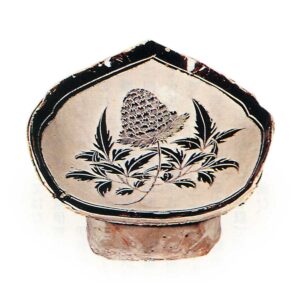
A ceramic pillow. It is widely referred to as “ceramic pillow,” although it is also called “瓷枕” and “枕” depending on its quality. In China, products from the Tang and Song dynasties were introduced early on, and the changes in design are fascinating. Generally hollow in shape, the pillows are filled with a single pebble and make a rattling sound.
Many of the Song dynasty ceramic pillows are of the Zizhou kiln type, and some are decorated with ink painting and spatula carving patterns. There are also splendid porcelain pillows made in the Bai Ding kiln. In North China, there is a dream story about Lusheng in Handan. The area is close to kilns in Porcelain Province and Neigu, and there is a famous pottery production area nearby. The tiger pillow is said to be a pillow in the shape of a crouching tiger to ward off evil. In Korea, too, there are porcelain pillows (original pronunciation: “tochim”), and there are also porcelain boards called “pillow corners” that decorate the ends of cloth pillows with carvings or blue and white flower decorations. In Japan, imported porcelain pillows were used in high society during the Heian period (794-1185), as described in “Jukunsho,” which says, “The right minister of Tokudaiji Temple is said to have dedicated a pillow made in the shape of a lion to his wife, who could not come to him without his permission. This is probably a pillow made of Chinese pottery in the shape of a baku (tapir) or a fed-up snake. Even in later times, there were rare users of ceramic pillows among literati, and they were said to be good for cooling the brain. Since the Meiji period (1868-1912), white porcelain corner pillows from the Seto area and elsewhere were exported mainly to Shanghai, China, and also to North China and the South Seas, but these were mostly unadorned, low-priced items.
The ceramic pillows of the porcelain kilns of the Goryeo Dynasty were also called “ceramic pillows.” The term “ceramic pillows” was also used for the kiln tools used in the kilns of the Joseon Dynasty, which were introduced to Japan along with the round kilns.



